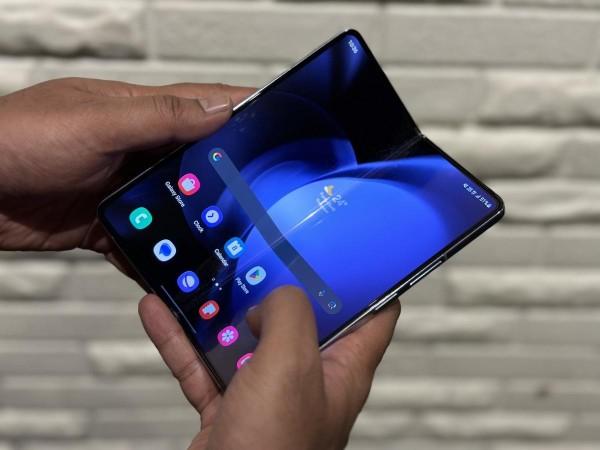The foldable smartphone space was still in its infancy back in 2019, but as years passed, it has become a prominent category and Samsung seems to be leading the race. With its Galaxy Fold-series, which marked the end of the much-celebrated Galaxy Note-series, Samsung has turned a niche category into a mainstream one with panache. The year 2023 is when Samsung is aspiring to perfect its portfolio, and the all-new Samsung Galaxy Z Fold 5 is a testament to that commitment.
International Business Times is currently reviewing the Galaxy Z Fold 5 for all that it offers, but first, let’s take a look at what the phone has to offer. Here are our first impressions of the Galaxy Z Fold 5.
Key specs at a glance
- Display: 7.6-inch QXGA+ Dynamic AMOLED 2X, Infinity Flex Display, ARR
- Cover display: 6.2-inch HD+ Dynamic AMOLED 2X Display, ARR
- Rear camera: 50MP wide-angle (OIS, f.18) + 12MP ultra-wide (f/2.2) + 10MP telephoto (3x)
- Cover camera: 10MP f/2.2
- Under display camera: 4MP f.18
- CPU: Qualcomm Snapdragon 8 Gen 2
- RAM: 12GB
- Storage: 256GB, 512GB, and 1TB
- Battery: 4,400 mAh
- OS: OneUI 5.1.1, based on Android 13
- Weight: 253g
- Add-ons: Fingerprint sensor, IPX8, Gorilla Glass Vitus 2
Pricing
Samsung Galaxy Z Fold 5 starts at Rs 154,999 for the base model with 256GB storage and goes on to Rs 164,000 for 512GB and Rs 184,000 for the high-end 1TB model. The phone comes in five shades of Icy Blue, Phantom Black, Blue, Gray and Cream.
Samsung India sent us the blue-hued variant with 256GB storage for review purposes.
First impressions
Samsung Galaxy Z Fold 5 comes in a flat box, thanks to the missing adaptor, which usually adds to the width of the box. The first thing we notice and appreciate is Samsung’s continued commitment to sustainability as the packaging uses recycled materials sans plastic use. The Galaxy Z Fold 5’s box is made with 100 percent recycled paper.
Before we go any further, it’s worth pointing out that the back glass deco film of the Galaxy Z Fold 5 contains 80% recycled PET. The sub window and back glass of the Galaxy Z Fold5 and Z Flip5 contains 22% recycled glass. The display connector cap of the Galaxy Z Fold5 and Z Flip5 contains 20% recycled ocean-bound plastic. Now that we have Samsung’s sustainability efforts noted, let’s look at the phone itself.
As we unboxed the Galaxy Z Fold 5, it immediately resembled the Fold 4 outlook, but with smarter and sharper design. All the difference is in how both these phones feel rather than how they look. The Galaxy Z Fold 5 is slimmer and lighter, making it easier to handle and use. To put things into perspective, the Galaxy Fold 5 weighs just 253 grams, and that’s impressive for a foldable phone.

Besides the weight and the sleekness, first thing we went looking for is the hinge gap or lack thereof in case of the Fold 5. In fact, Samsung’s new Zero Gap Flex Hinge is the reason why the phone appears slimmer than the Fold 4 and much more appealing. We tested this by placing the phone in unfolded state flat on the table and you can guess the outcome. When we folded the phone, there’s hardly any gap between the screens. It’s basically what consumers had asked for and Samsung has delivered it.

Samsung Galaxy Z Fold 5 has an aluminium frame, which complements the Icy Blue shade really well. This is besides the durability it adds to the phone. Speaking of which, the phone is IPX8 certified, which means it is water resistant. The glass protection used on the phone is Victus 2, which is the toughest solution out there. It is not break-proof, but surely adds high level of protection against scratches, which we learned as we carried the phone around in the pocket alongside some coins and keys. But adding that extra bit of care doesn’t hurt.

The biggest concern that comes with a foldable phone is the hinge and Samsung says the Fold 5 can withstand 200,00 folds over 5 years of daily use, which is almost as long as the software support provided to the Samsung device.

Coming to the display, a lot remains unchanged. The 6.2-inch HD+ Dynamic AMOLED 2X display on the cover with adaptive refresh rate offers smooth operations, but the real gem is the main display, which is a beautiful 7.6-inch QXGA+ Dynamic AMOLED 2X, Infinity Flex screen. At 120Hz adaptive refresh rate, the display is really smooth and we can only imagine how smooth the S-Pen support would be. What’s really improved in terms of display is the brightness, which goes as high as 1750 nits, which translates to “great visibility in bright outdoor conditions” in layman terms.
1/
The cover display still has some bezels and unlike the main display, there’s no under-display camera. The bezels surrounding the cover display are hard to ignore, but since we use almost all the apps in Dark Theme, there’s very little reason to crib.

One of the things we loved about the main display is the improved Taskbar, which you can enable from Settings > Display if it isn’t already turned on. It takes multi-tasking to a new level by adding up to four recent apps in the non-docked section. And one fun feature is the Flex Mode, which turns the Fold 5 into a mini laptop. It was really a flex feature, but with a practical touch.


The physical buttons haven’t changed either. The fingerprint sensor is integrated within the power/lock button, the volume controls sit above it on the right side. The USB Type-C (3.2 Gen 1) port can be found at the bottom and the stereo speakers take top and bottom positions, which add for a nice surround while using the phone in unfolded state.

There’s a minor change in the main camera module of the Galaxy Fold 5. The LED flash has now been shifted outside the pill-shaped camera island, reserving it just for the three sensors. Even the camera rings now match the aluminium chassis instead of being black as found on the Fold 4. This covers the design and display aspect of the phone, leaving us explore the other areas.

The cameras on the Galaxy Z Fold 5 haven’t been changed. It carries the same sensors as on the Fold 4, which some may find disappointing, but the cameras aren’t bad for shooting as we’ve seen with the Fold 4. The 50MP+12MP+10MP on the rear camera, and 10MP on the cover and another 4MP on the main display suffices most needs.

There’s an improvement in performance, slight albeit. The Fold 5 is now powered by Snapdragon 8 Gen 2, which is paired with 12GB RAM as standard. We haven’t had any issues with the performance aspect and the OneUI 5.1.1 is really a refined interface for the foldable model. The phone held up well with demanding tasks, but we’ll be testing it with more demanding tasks as we continue our review. Stay tuned for our comprehensive take on the Galaxy Fold 5’s performance, camera and battery soon.









